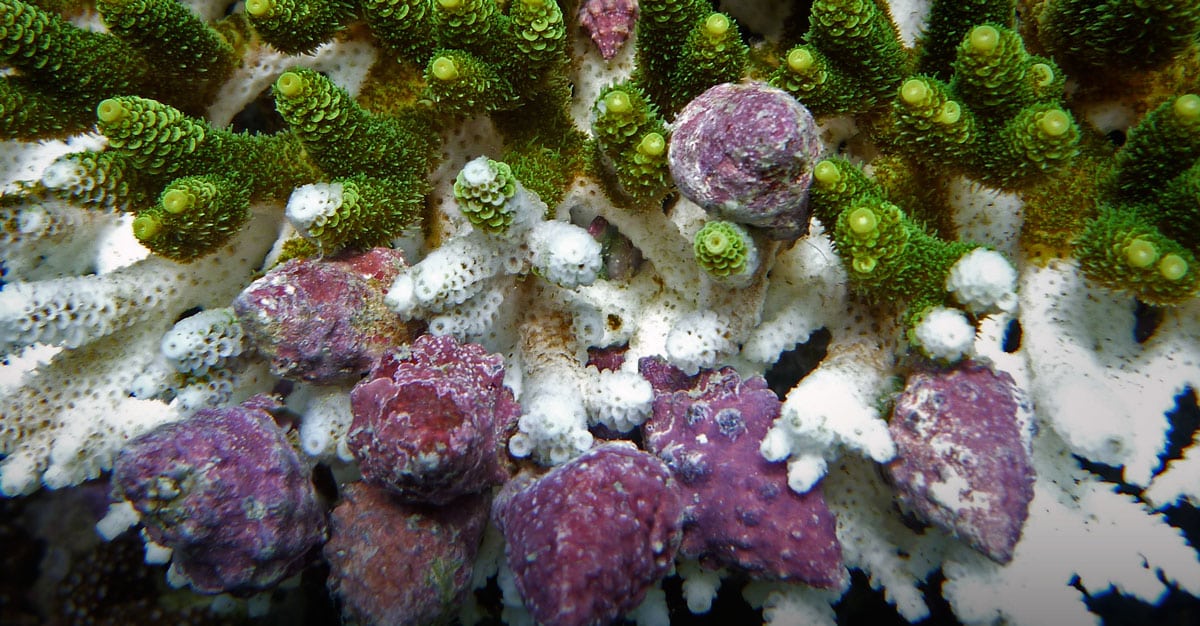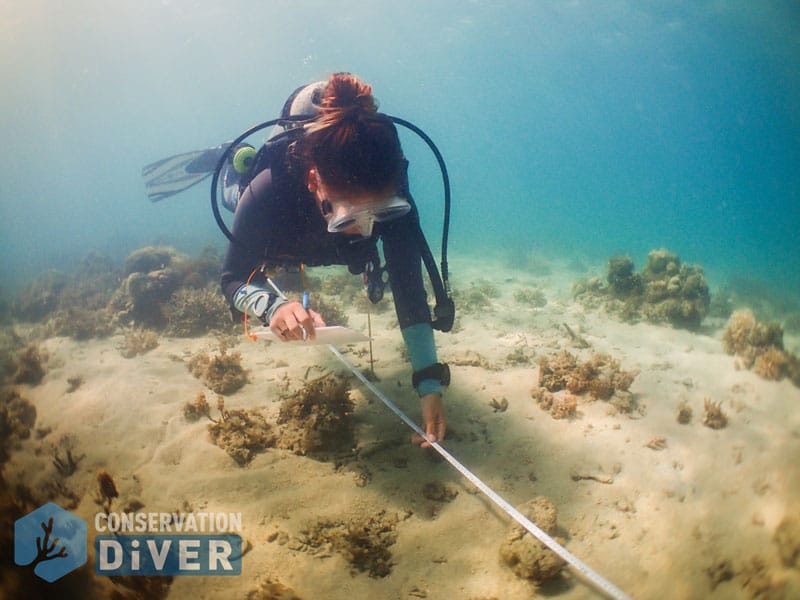Understanding Corallivorous Drupella Snails
Although outbreaks of corallivorous Drupella snails have been increasing across the Indo-Pacific since the 1980s, still very little is known about their reproductive ecology. These tiny snails can occur in great abundance and can contribute to reef decline by lowering the total abundance of living coral and changing the population structure of reef communities.

Tracking these Coral Predators
Conservation Diver has been focusing on Drupellas for some time, with our first observation of the snails shifting their preferred food sources following the global mass coral bleaching event of 2010. Since then, our partners at the New Heaven Reef Conservation Program have collected more than 179,740 Drupella snails from around the island of Koh Tao, with 76% coming from a single bay.
In 2019, a team of our Conservation Diver Trainers traveled to Mauritius for a collaborative research expedition with the University of Mauritius. They were pleased to apply their Drupella snail knowledge to the local reefs and assist published Drupella snail researcher Deepeeka Kaullysing, in recording observations from the area. During their biodiversity surveys, primarily focused on heterobranchs, they noticed a significant deposition of egg masses under mushroom corals in the vicinity of a large Drupella aggregation. Upon closer inspection, they realized they were looking at the largest concentration of Drupella egg clusters ever recorded.
Although the first outbreak of Drupella snails was recorded in the early 1980s, much of what we understand about their life history is derived from similar organisms. Very few publications detail observations of the egg or larval stage of these predators, which is vital to know to mitigate the damage caused by over-populations or outbreaks.
Understanding Drupella Lifecycles
The first recorded Drupella egg deposition was published by Sam et al. in 2016 in an aquarium. This was followed quickly by the first in situ observation in 2017 by Scott et al. and was also the first record of egg deposition on the underside of Fungiidae corals.

The recent Kaullysing et al. (2020) publication is the first record of Drupella egg deposition in Mauritius and the Western Indian Ocean. Additionally, this is the first record of in situ egg deposition on corals other than Fungia. This time, eggs were observed on Fungia, Montipora, and the shell of another Drupella snail.
Furthermore, it represents the highest abundance of corallivorous Drupella eggs ever observed, with 5,020 egg bundles on a single coral (each bundle contained approximately 96 embryos).
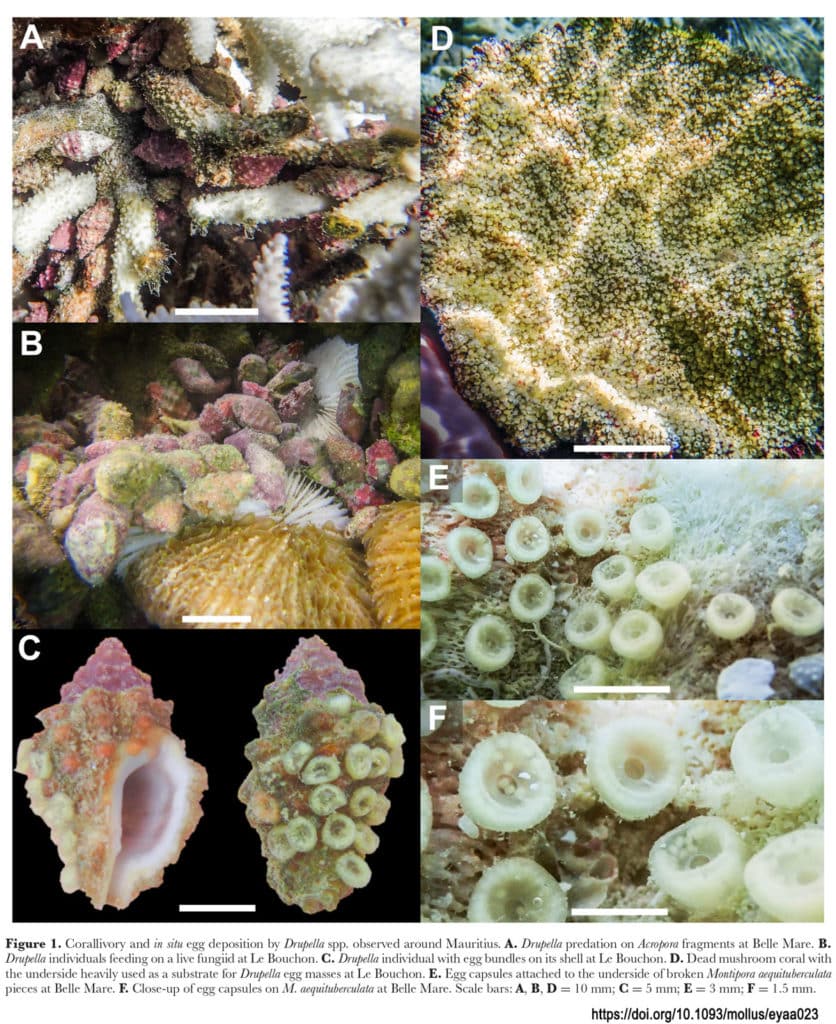
Observations such as these are vital to the understanding of the ecology and life history of these cryptic species. Only 40 years ago, they were essentially unheard of, yet today they are seen as one of the Indo-Pacific's significant problematic coral predators.
Stopping Outbreaks of Drupella
To halt outbreaks and mitigate their damage, reef managers must understand the details of their life history. By targeting benthic egg cases for removal rather than the adults, much time and resources could be saved.
The program on Koh Tao has been working for a decade to remove nearly 180,000 adult snails, whereas removing just the observed corals in Mauritius could potentially prevent the dispersal of 1.6 million embryos (4 corals x 5,000 egg bundles each x 80 embryos per egg bundle).
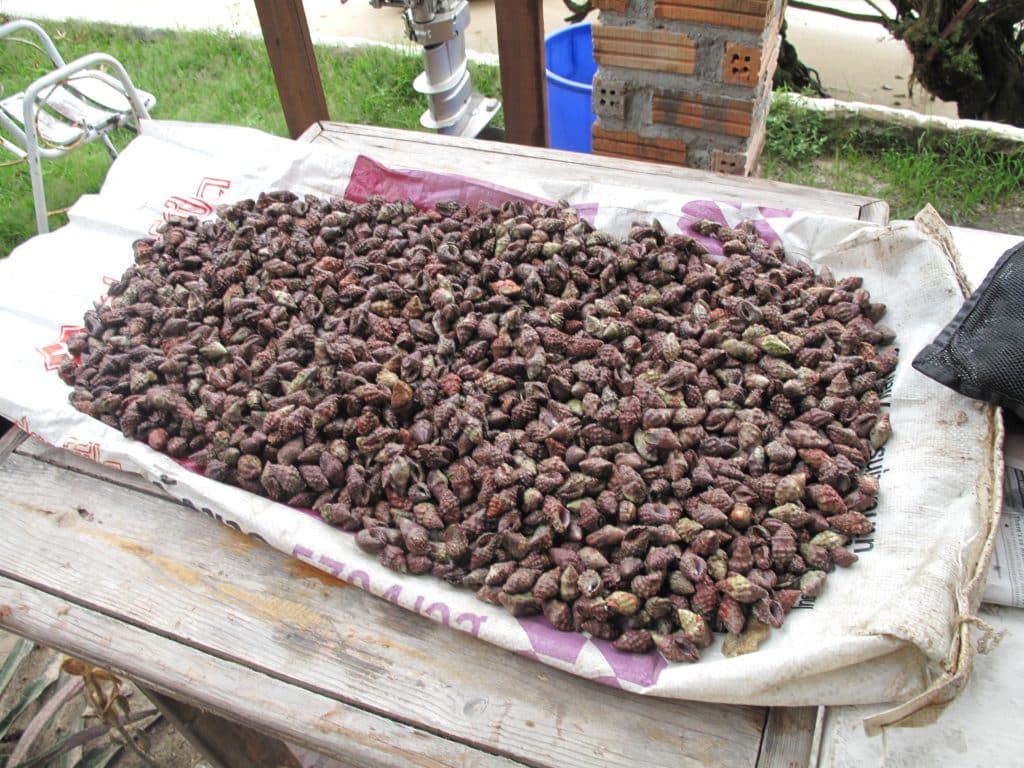
This is a very important publication for the advancement of this field and surely will be one of the stones placed on the path to better understanding and management guidelines for these pervasive coral predators. We wish our sincerest gratitude and congratulations to all of the authors, but especially those on the Conservation Diver team; Rahul Mehrotra, Spencer Arnold, Alyssa Allchurch, and Elouise Haskin.
Be sure to check out the paper here
Helping to assess reefs around the globe
The programs and courses offered by Conservation Diver were originally developed alongside local reef managers in an effort to increase the effectiveness and financial sustainability of their valuable work. Increasingly, the protocols and techniques developed under the Conservation Diver syllabus have been applied to promote or improve conservation strategies at various scales in several countries, such as to assess reefs in areas of need.
Last month, research director Rahul Mehrotra and a team of Conservation Divers published their third study, in which skills taught through our courses were applied to promote informed conservation decisions. This time assessments were requested by the government of the Escalante region of the Philippines, including a Marine Protected Area (MPA) that was established 15 years prior. This is the third such expedition Rahul and the team have undertaken and published, and is invaluable for the local governments to assess the actions already taken, and direct the policies that will decide the future fate of the areas and their resources.
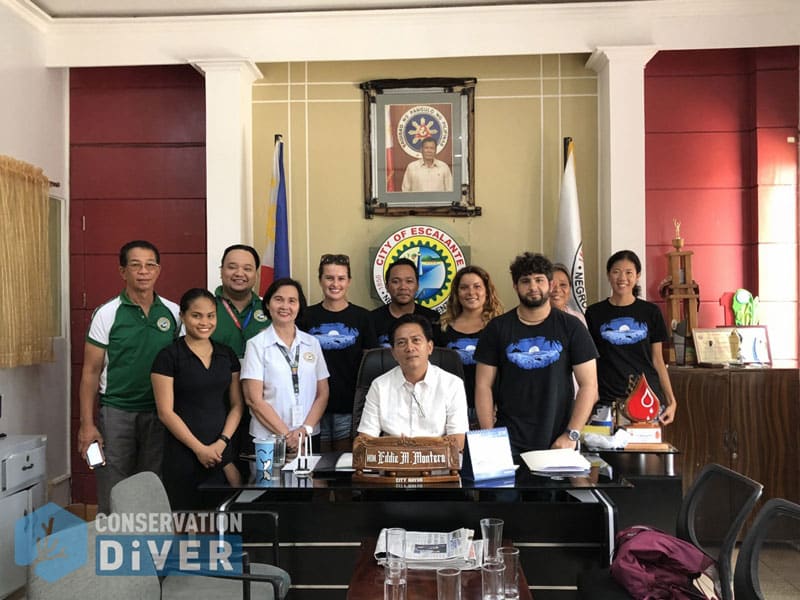
The project was supported and carried out in collaboration with our partners at the Love Wildlife Foundation and the University of the Philippines, Cebu. The researchers involved were all trained and certified in Conservation Diver monitoring and data collection techniques, and were thus more than proficient and prepared for the job at hand. Most of the surveys were carried out using SCUBA equipment while diving in coral reef and muck habitats, but additional surveys were also carried out by snorkeling in mangroves and sea grass beds, and by visiting local fish markets.
The team was able to identify and record more than 700 species during the surveys in Escalante, including 191 species of fish, 227 species of cnidarians (corals and related animals), 120 species of mollusks, 58 species of echinoderms , 40 species of crustaceans, and 27 species from the Platyhelminthes phylum (flatworms and their relatives). These findings provide indications that the marine habitats of the area are highly biodiverse, but evidence was also provided showing that they are in dire need of increased protection and enforcement of existing regulations.
Hard coral cover was generally considered ‘fair’ (as most of the country’s reefs were in previous studies), ranging from 16%-66%, with most sites surveyed having coverage greater than 30%. The team was also excited to record coral spawning during the surveys, observing gamete bundles released from both Montipora and Lobophyllia on March 7th. They then witnessed sea urchins and clams spawning during a daytime in a mass event occurring one week later, on March 14th.
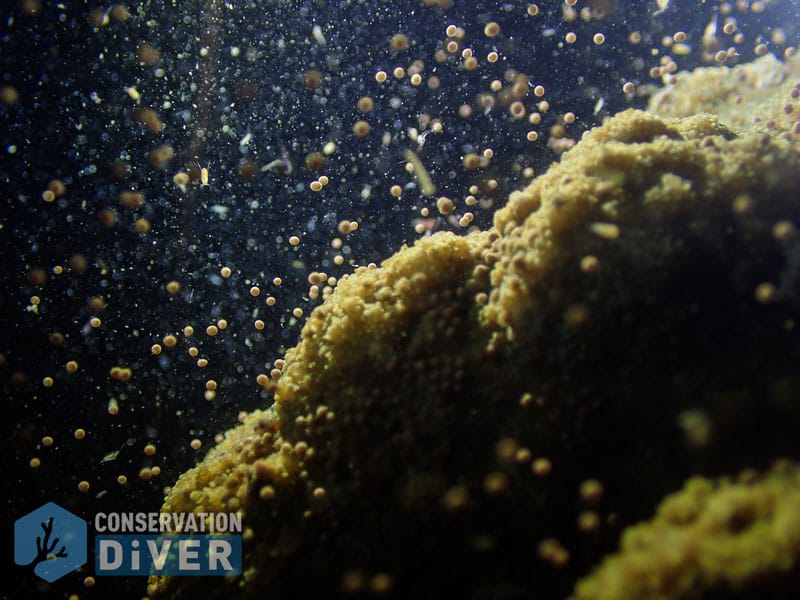
The data collected during all the various surveys was used to write a report in order to advise policy changes for the local government. Those changes included zoning to protect the most valuable areas, but still allow for regulated commercial use in order to sustain local economies and livelihoods. It was recognized by the authors that the current MPA’s regulations and enforcement make it ineffective at achieving the original goals as set out 15 years ago. The paper recommended broader participation in decision making and enforcement of the regulations, requiring more stakeholder education and participation. The team also recommended some areas be designated for responsible tourism in order to provide alternative, non-extractive revenue streams for the local communities. Lastly, the authors recommended infrastructure additions such as mooring lines to reduce incidences of anchor damage to the delicate reefs.

This study is something which we at Conservation Diver are quite proud of, not only for its potential impact on policy and sustainability of the reefs in the region, but as a proof of concept of our training system. The thousands of certified students that have been through our programs are proof that there is demand for this type of training; and our success on the local scale, such as on the island of Koh Tao, has proven that we are able to make a tangible difference through the active participation of trained divers as well as create sustainable funding streams to ensure the success of long-term monitoring, protection, and restoration projects. But this expedition in particular also shows that there is a wider application to our methods and techniques that can be utilized to advise governments around the world to make science-based decisions uniquely established for their region, local communities, and customs. We hope to send out more teams on expeditions like this in the future to assess reef health, create more collaborations with local universities and governments, and help to fill in the gaps between those two groups. In doing so, we think that we can create an effective nexus that can realize tangible positive changes in the way that we manage and use our finite reef resources and ensuring that these ecosystems persist and thrive
Download the full report here

A New Species of Coral-Eating Nudibranch
A new species of coralllivorous nudibranch has just been discovered by our friend and colleague, Dr. Rahul Mehrotra. The new species, which he named Phestilla viei, was described in a recent article in the journal Marine Biodiversity, titled “A new species of coral-feeding nudibranch (Mollusca: Gastropoda) from the Gulf of Thailand.” Not only does this paper provide record of this new species, but it also helps to clarify the systematics of the genera, which currently contains 8 coral-feeding species that have been revised several times over the last few decades.

This study was conducted as part of Rahul’s PhD, which has yielded several other impressive firsts for the world of sea slugs, including the observation that there are corals which feed on sea slugs, as well as three other first records of species found from Koh Tao; including Unidentia aliciae in 2019, as well as Arminia occulta and Armina scotti in 2017.
The new species, Phestilla viei, was first found on the island of Koh Tao, Thailand by Conservation Diver board member, Spencer Arnold, who was a co-author on the paper. He found the first individual on a coral of the species Pavona explanulata, a resilient coral species which is becoming more prevalent on the island as it replaces some of the less robust species in the face of climate change and localized anthropogenic stresses. The novel species was named after local nudibranch enthusiast and citizen scientists, Mr. Vie Panyarachun, well known for his vast contributions in recording and curating sea slug records from Thai waters.
After the first observation, Rahul and his team conducted a series of surveys to locate more individuals and evaluate their ecology, anatomy, and genetics. All of the individuals found were on the same species of coral, implying that they are an obligate parasite of the sceleractinian, Pavona. Because of this obligate relationship, the morphology of the nudibranch is such that it closely resembles the coral, making it very difficult to find. Rahul and his co-authors stated in the paper that the easiest way to find them is to actually look for the feeding scars and egg trails, and then to look for the individuals making them.
Another amazing trait which makes this cryptic species so difficult to observe is that it actually ‘steals’ symbiodinium (the unicellular algae which power the coral) and integrates them into their bodies rather than digesting them, in a process termed “kleptosymbiosis.” Although this species is a corallivore, it does not appear to be a major threat to coral populations, as it was never observed to eat the entire coral, and no overpopulations or outbreaks have been documented.
Although this was the first scientific description, observations of the species have been made in other parts of the Western Pacific, including Indonesia, Madagascar, Papua New Guinea, and the Philippines. Now that more divers know about this species, and where to look for it, surely it will be observed in many other countries over the next few years.
After reading the article, we had some questions for Dr. Mehrotra, so we interrupted his work to interview him about his findings and current projects.
Q1: This is a very interesting finding, when did you first become aware of these species, and how did you first spot it?
I came across reference to a similar species in a couple of references, however with very little corresponding information. After finding a paper documenting this from Hong Kong feeding on Pavona decussata, I considered the possibility that we may have this on Koh Tao. The truth is, I simply needed to share this paper with Spencer who used his remarkable skills in a matter of weeks to find a similar species feeding on a different prey at Koh Tao.
Q2:As this is the fourth new species you have described for the region, do you think Koh Tao is a particular hotspot for sea slugs, or do you expect other regions in the Gulf to have similar levels of biodiversity?
This is the fourth species of nudibranch to be described from Koh Tao, which has indeed been the home of much of the sea slug research from Thailand over the past decade. However, our data from other locations suggests that, while Koh Tao does seem to offer a diversity of species distinct from what is commonly found elsewhere in the Gulf, the richness of discoveries is largely due to the focused study in the area. Many places in Thailand appear to host species that are awaiting a closer investigation.
Q3: You named this nudibranch after Mr. Vie Panyarachu, how has he influenced your work over the years, or the status of nudibranchs in Thailand in general?
Vie Panyarachun is a keen recreational diver and naturalist who has played a remarkable role in curating records of sea slug diversity in the country. His work as a citizen scientist has helped create a repository of species as well as playing an active role in sharing the world of sea slugs with the SCUBA diving community in Thailand.
Q4: why do you think it is important that populations of nudibranchs in the region are recorded and monitored?
Nudibranchs and other sea slugs have been shown to play a variety of roles economically and ecologically, however few of these have been investigated thoroughly. Monitoring sea slug diversity has already led to remarkable documentation on the hidden impacts of climate change and species invasions. The importance of monitoring sea slugs in the Western-Pacific, home to the most biodiverse marine environments in the world, allows us to dig deeper into the complex ecology of the region. In a time where hundreds of invertebrate species are known to have been regionally displaced or gone extinct only to be discovered/rediscovered after the fact, detailed monitoring of such understudied groups may allow us to catch large scale threats before they take hold. Many sea slugs have been associated with very specific prey organisms, and thus the fate of any given species is also intricately tied to the resilience of its prey. The species we describe here for example has been found exclusively on a single species of coral, with similar species of coral either hosting their own distinct species of nudibranch, or none at all. Many reef building corals such as the prey of P. viei are susceptible to threats such as coral bleaching. We have little evidence at present to suggest that populations of P. viei would could show enough dietary plasticity to shift hosts to a more resilient prey should these threats escalate.
Q5: What are you currently working on, or towards, regarding sea slugs in Thailand?
I am in the process of completing my work from Koh Tao, documenting further ecologically relevant observations. My work on sea slugs will be transitioning to other fields soon too, so as to provide a more solid framework for further research on sea slug biology in Thailand.
We want to pass our sincerest congratulations to Rahul for this valuable and important work, and wish him all the best in his future ventures, which we follow very closely and support in any way we can. We also want to congratulate Spencer Arnold on his find, and his invaluable assistance to this study, he has an eye for finding tiny sea slugs like no one else. We also want to congratulate Mr. Vei on the species being named for him, and for all his contributions to the field over the years.
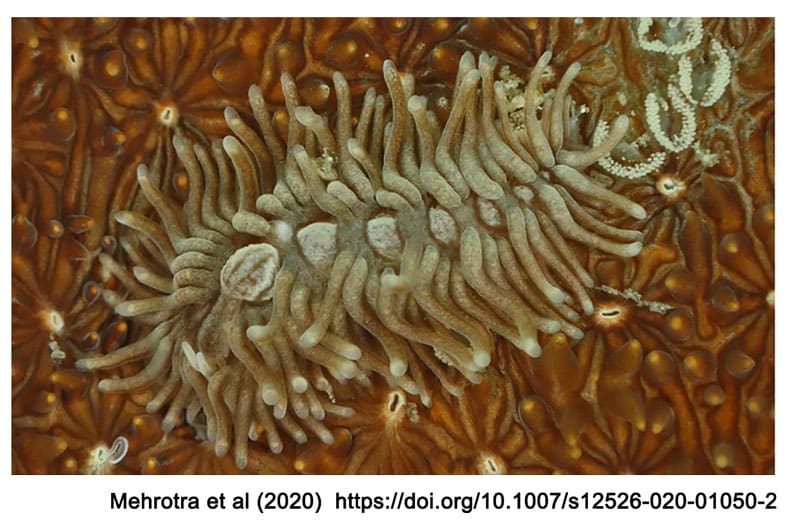
Corals Have Evolved to Eat Sea Slugs
Hard corals are generally thought of as autotrophs, or organisms which produce most of their own metabolic energy and contribute to the base of the food chain in the ecosystem. Although most reef-building corals do feed on plankton, they meet 75-95% of their energy demands by harvesting symbiotic micro-algae within their tissues, and are thus getting their sugars and carbohydrates indirectly through photosynthesis. However, this view of corals is currently in debate, and it looks like a more diversified diet could be utilized by some corals to meet their daily energy demands. This has been the study of Conservation Diver Instructor and Board Member, Rahul Mehrotra.
Investigating what corals can eat
Initially, Rahul showed back in 2015 that Heteropsammia corals used their large mouth size to opportunistically consume salps during seasonal blooms. This was observed In Situ on several occasions in the ‘muck’ areas around Koh Tao, and documented in the journal Marine Biodiversity. By chance, a student of the New Heaven Reef Conservation Program, Joel Rohrer observed a mushroom coral ingesting a sea slug during a coral reef survey, and alerted it to Rahul’s attention. From that single observation, investigations began into the question, “Are reef building corals actively feeding on sea slugs for additional energy?” A question which would take 4 years to investigate.
Experiments were devised as a series of both in situ and ex-situ trials to test his hypothesis, which was that corals take advantage of their proximity with Sacoglossan sea slugs and their large gape to facilitate heterotrophy. The experiment looked at several factors, the size of the coral, the size and species of the sea slug, and the likelihood of ingestion. He used aquarium feeding trials to test whether or not it was even possible for the mushroom corals to capture, transport, and ingest the slugs, and looked at the rate of rejection based on slug size and species. Following those trials, he also performed field tests to ensure that this adaptation was actually going on in the wild populations.
The study’s conclusions
Based on 240 trials, it was concluded that prey species and prey size are the greatest factors in successful predation of sea slugs by corals, rather than the type or size of the corals themselves. Of the six species of prey slugs tested, consumption rates were highest for species of the genera Costasiella and Elysia, with significantly less success when attempting to ingest those of the Plakobranchus genus. Additionally, when these sea slugs were rejected after consumption by the corals, the slugs were covered with a mucus that is thought to be a defensive mechanism by the corals to prevent damage caused by the slug’s defensive measures.
What this means
Rahul’s work has helped to expand the way we think about coral feeding behaviors, as well as their place in the trophic structure of reefs. We now know that they feed on large plankton (salps and small jellyfish) in addition to the nearly microscopic prey they have always been known to. Furthermore, we now see that they are actively feeding on benthic organisms, not only those floating in the water column. This may be an adaptation to increase the amount of energy they receive from heterotrophy to allow them less reliance on their symbiotic algae, or as a way to gain beneficial micro- and macro-nutrients that could be essential for their growth and development. Additionally, the data adds to the incredibly sparse understanding on predators of sea slugs (which are all toxic) and overall ecology in tropical reef habitats. As these new observations are investigated further, we are sure they will yield some more surprising and exciting information which will continue to modify our views of this very important class of reef organisms.
The full paper is available free of charge from the publisher's website

